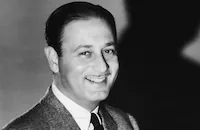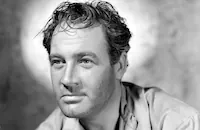Maisie

Brief Synopsis
Cast & Crew
Edwin L. Marin
Robert Young
Ann Sothern
Ruth Hussey
Ian Hunter
Cliff Edwards
Film Details
Technical Specs

Synopsis
Maisie Ravier, a spitfire from the vaudeville circuit, is stranded, penniless, in a small Wyoming town where she meets "Slim" Martin, the manager of a ranch owned by Clifford Ames. Slim, who distrusts all women because of the pain one caused him, rejects Maisie's flirtations and orders her to leave town. At the railroad station, Maisie meets Ames and his adulterous wife Sybil, who have come West to patch up their marriage, and tells them that Slim has hired her to be Sybil's maid. While Maisie befriends the lonely Ames, Sybil, who has married Ames for his money, sends for her lover, Richard Raymond. When Ames is involved in an accident that leaves him trapped in his car, Maisie goes for help and finds Sybil with her lover. That night, Maisie and Slim declare their love for each other and decide to marry, and Maisie, troubled by Sybil's infidelity, insists upon leaving the ranch. Before leaving, Maisie confronts Sybil about her treatment of Ames, and Sybil turns the tables on Maisie by telling Slim that Maisie is in love with Ames. Sybil's lies trigger a fight between Maisie and Slim, and Maisie leaves the ranch in anger. Meanwhile, a despondent Ames has realized that his wife is cheating on him and, after mailing a letter to his lawyer, kills himself. When Maisie learns that Slim is on trial for killing Ames, she rushes to the courtroom. There Ames's lawyer finds her and presents her with a letter from Ames. The letter is a suicide note that clears Slim and wills the ranch to Maisie. All ends happily as Slim and Maisie plan to marry and live together on the ranch.

Director

Edwin L. Marin
Cast

Robert Young

Ann Sothern

Ruth Hussey

Ian Hunter

Cliff Edwards
Anthony Allan
Art Mix

George Tobias

Richard Carle

Minor Watson
Harlan Briggs
Paul Everton

Joseph Crehan

Frank Puglia
Willie Fung

Emmett Vogan
Mary Foy
Frank Darien

Clem Bevans
Charles Coleman
Robert Middlemass
Robert Winkler
Marty Faust
Roy Seager
Don Roberts
Frank Mills
Buck Mack
Charles Dorety
Ralph Mccullough
Eddie Randolph
C. L. Sherwood
Crew
Malcolm Brown
Cedric Gibbons
Robert Golden
Mary Mccall Jr.
J. Walter Ruben
Douglas Shearer
Frederick Y. Smith
Leonard Smith
Dolly Tree
Valles
Edward Ward
Edwin B. Willis

Photo Collections
Videos
Movie Clip
Trailer
Hosted Intro
Film Details
Technical Specs

Articles
Maisie
Meanwhile, at MGM producer J. Walter Ruben was looking for a Jean Harlow type - blonde, sexy, somewhat vulgar, definitely sassy. He had a script that had been intended for Harlow, which had been shelved after the actress's untimely death in 1937. Ruben saw Trade Winds, and decided Ann Sothern would be perfect for the lead in Maisie (1939).
Maisie Ravier is a small-time showgirl, a "honky-tonk chorine with a heart of spun sugar," in the words of film historians James Robert Parish and Ronald L. Bowers, "traveling to every part of the globe as conceived by the set decorators." In this - the first of what would ultimately become a 10-film series over a period of eight years - Maisie travels to Ian Hunter's ranch, straightens out his marital problems, has a romance of her own with Robert Young, and solves a murder. It's a modest little programmer, just 72 minutes long. But as Sothern would later say, "Maisie and I were just together - I just understood her." The public did, too - she was one of them. Maisie, and Ann Sothern, were a huge hit. MGM immediately signed Sothern to a 10-year contract. The series was so popular that mail addressed to "Maisie, U.S.A." reached Sothern at MGM. The Maisie films may have been B-pictures, but Ann Sothern was queen of the B's.
The series made Sothern - and also stifled her. MGM chief Louis B. Mayer was happy to cast her in an occasional prestige film, like Panama Hattie (1942) and Cry Havoc (1943), but he made it clear that Maisie was the studio's bread and butter, and Sothern's priority. "Your pictures pay for our mistakes," Mayer told her. "And you'll just keep making Maisies as long as you do that."
Ultimately, Maisie did not take Ann Sothern where she wanted to go. Sothern herself would admit she was "a Hollywood princess, not a Hollywood queen." But the series made her known and loved the world over.
Director: Edwin L. Marin
Producer: J. Walter Ruben
Screenplay: Mary C. McCall, Jr., based on the novel Dark Dame, by Wilson Collison
Editor: Fredrick Y. Smith
Cinematography: Leonard Smith
Art Direction: Cedric Gibbons, Malcolm Brown
Costume Design: Dolly Tree, Valles
Cast: Ann Sothern (Maisie Ravier), Robert Young (Slim Martin), Ruth Hussey (Sybil Ames), Ian Hunter (Clifford Ames), Cliff Edwards (Shorty).
BW-75m. Closed captioning.
by Margarita Landazuri

Maisie
TCM Remembers - Ann Sothern
TCM Remembers - Ann Sothern
Quotes
Trivia
Story was originally purchased for Jean Harlow
Notes
The working titles of this picture were Maisie Was A Lady and Broadway to Wyoming. A news item in Hollywood Reporter notes that the picture was shot on location near Chatsworth, CA. This was the first picture in M-G-M's "Maisie" series. The series, based on a character created by Wilson Collison and starring Ann Sothern as a brassy showgirl, consisted of ten films produced by M-G-M from 1939-1947. The last film in the series was Undercover Maisie. Sothern also starred in the CBS radio series Maisie, which began in 1945. For additional information about the series, consult the Series Index.

















